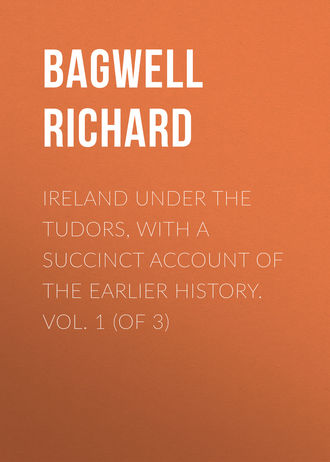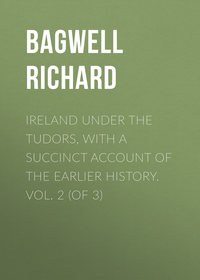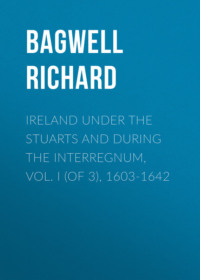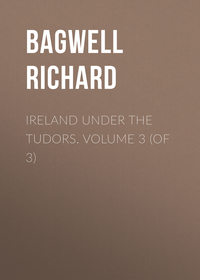 полная версия
полная версияIreland under the Tudors, with a Succinct Account of the Earlier History. Vol. 1 (of 3)
10
‘Marriages in Ireland,’ says Dr. Sullivan, ‘were not regulated by canon law. The Irish marriage customs were in full force long after the Norman conquest. According to these customs, which appear to have been wholly uninfluenced by the canon law, bastardy was entirely different from what that term implied in countries under canon law, and in modern times. The Irish marriage customs should consequently be taken into account here, as they sanctioned a kind of polygamy, divorce, &c. See also the excommunication in 1282, by the Archbishop of Canterbury against Llewellyn, Prince of Wales, at the request of Edward I., in which the marriage customs of the Welsh, identical with those of the Irish, constitute one of the charges.’
11
Le Résolution des justices touchant le Irish custome de gavelkind. Reported by Sir John Davies, A.G., 3 Jac. i.
12
Dr. Sullivan believes the story of the decision against Columba to be a mere myth.
13
‘The Irish Church,’ says Dr. Sullivan, ‘had undoubtedly two distinct phases of monasticism: one that of the Patrician period – an obscure but highly important and interesting phase; the other, that of the sixth and subsequent centuries, to which the Irish missionaries belonged.’
14
‘Besides,’ says Dr. Sullivan, ‘the monastic bishop proper, who furnished the wandering Scotic bishops of the Middle Ages, there is a later development of a higher church organisation in the tribal bishop, who was a close approximation to a diocesan bishop. The tribal bishop was a bishop who had jurisdiction over the whole of a Tuath, and sometimes even a Mór Tuath. The growth of territorial jurisdiction is well marked by the prestige attached to the office – the bishop ranked in fact almost on a level with the chief, and was entitled to the same legal retinue. Many of the ancient dioceses, and some of the existing ones, e. g. Ross, Kilmacduagh, Kilfenora, represent ancient Tuaths, or tribe territories. Several deaneries were former dioceses, and are co-extensive with ancient Tuatha.
15
Dr. Sullivan warns me not to attribute too much influence to the Danish Church. ‘The tribe-bishop,’ he says, ‘was a much earlier development, and proves the growth of diocesan jurisdiction and the consequent merging of the Irish Church in the Latin Church. The acceptance of the Roman time for celebrating Easter by the Irish Church and the constant intercourse between Ireland and the Continent had brought the Irish Church fully under Roman supremacy three and a half centuries earlier. What really took place in the early part of the twelfth century was the more complete adoption of the organisation of the Western Church, and of the principles of the canon law; and especially the granting of lands and charters to the Church in the same way as in feudal lands. The marriage of Irish princes with Saxon and other foreign princesses, and the growth of towns which helped to relax its rigid tribal system, did more than the Danish Church.’ The chief towns were, however, of Danish origin.
16
The account which Giraldus gives of Turgesius is funny, but worthless.
17
Reeves’s Adamnan, p. 332 n.
18
Wars of the Gaedhill with the Gaill, chap. xxxvi.
19
Wars of the Gaedhill with the Gaill, chap. xl.
20
The quotations are from Burnt Njal, chap. cliii.
21
Burnt Njal, chap. cliv.
22
Ibid., chap. clvi. Wars of the Gaedhill with the Gaill, chaps. xcviii. and xcix. Annals of Lough Cé, pp. 7-13.
23
Burnt Njal, chap. clvi.
24
Many details about the Hiberno-Norse coins are to be found in Worsaae.
25
Book of Rights, pp. 225 sqq., and O’Donovan’s preface.
26
See Hook’s Lives of Lanfranc, Anselm, and Ralph d’Eures. Translations of the letters mentioned in the text may be found in King’s Primer of the Irish Church; most of the originals are printed in Ussher’s Sylloge.
27
The Irish always called Dublin Ath-cliath, or the Ford of Hurdles.
28
The great mine of knowledge about the Irish Scandinavians is Todd’s Wars of the Gaedhill with the Gaill, in the Record series. I have also used Dasent’s Story of Burnt Njal, and Anderson’s Orkneyinga Saga. Haliday’s Scandinavian Kingdom of Dublin, edited by Mr. J. P. Prendergast, is a good modern book. Worsaae’s Danes and Norwegians is said to be somewhat fanciful, but it contains information not readily accessible elsewhere.

29
Matthew Paris calls the Irish ‘bestiales.’
30
See the Senchus Mór, ii. 225.
31
Giraldus, Ex. Hib. lib. i. cap. 2.
32
In Webb’s Compendium of Irish Biography is a carefully compiled catalogue of Nesta’s children and grandchildren. I have generally followed it, noting, however, that Fitz-Stephen’s children cannot be held legitimate in the face of Giraldus’ distinct statement.
33
The details of Henry’s preparations may be studied in Sweetman’s Calendar of Documents.
34
In narrating the events of Henry II.’s reign, I have generally followed Giraldus Cambrensis, checking him by references to Hoveden and Regan. The Expugnatio may be considered a fanciful book in some ways. But if we eliminate everything supernatural, and make some allowance for the writer’s prejudices, I see no reason to question his good faith. Of the native Irish he knew little, but the invaders were his neighbours, friends, and relations. Fitz-Stephen and the other descendants of Nesta may be unduly praised, Fitz-Adelm perhaps unduly blamed; but, after all, this is no more than may be said against most historians of their own times. Giraldus was undoubtedly an observer of first-rate power.
35
The quotations are from Gilbert’s Historic and Municipal Documents of Ireland, pp. xxviii. and xxx.
36
Hardiman’s History of Galway contains as much as most readers will care to know about that town. The following distich makes it possible to remember the tribes: —
Athy, Blake, Bodkin, Browne, Deane, Darcy, Lynch, Joyce, Kirwan, Martin, Morris, Skerrett, French.
To which Ffont or Faunt must be added
37
The quarrels of Waterford with the O’Driscolls are given in the Calendar of Carew MSS., Miscellaneous vol. p. 470. Smith refers to a MS. in Trinity College.
38
Besides those in the Statute Book many Irish Acts of Edward IV.’s reign may be studied in Hardiman’s Statute of Kilkenny.
39
Stubbs’s Const. Hist., chap. xv.; Lynch’s Feudal Dignities, chaps. iii. and xi.
40
Sweetman’s Calendar of Documents, 1289; Lynch, supra.
41
The record is printed from the Black Book of Christ Church, in the Miscellany of the Irish Archæological Society.
42
Lynch, ut supra.
43
Lynch, ut supra; Lodge’s Register; Hardiman’s Statute of Kilkenny.
44
The names of those summoned to the Parliament of 1311 are printed by Lynch, chap. ii.; the names of those who attended in 1560 are in Tracts Relating to Ireland, vol. ii., Appendix II.
45
Cotton’s Fasti; Alemand’s Histoire Monastique; Lynch, chaps. iii. and vii.
46
Irish Statutes, 28 Hen. VIII. cap. 12.
47
See the list of chief governors in Harris’s Ware; Borlase’s Reduction of Ireland; Lodge’s Patentee Officers; and Gilbert’s Viceroys.
48
History of St. Canice, by Graves and Prim, especially pp. 187 and 193; also Mr. Graves’s Presentments, p. 79; Archdall’s Lodge’s Peerage, art. ‘Mount Garrett.’
49
It is hard to say whether the instructions for John Estrete, attributed by Mr. Gairdner to the very beginning of Henry’s reign, are by him or by Richard III. Henry would hardly have promised to make Kildare Deputy for ten years on condition of his going to Court, and the allusions to Edward IV. are more likely to have been made by Richard. —Letters of Richard III. and Henry VII., vol. i. p. 91. The three letters in the Appendix cannot be earlier than 1488.
50
Writing to Morton or Fox, Octavian says, ‘Profano coronationis pueri in Hiberniâ sceleri, me solo excepto, nullus obstitit manifeste.’ This hardly gives due credit to the Bishop of Clogher. —Letters of Richard III. and Henry VII., vol. i. p. 383. Henry’s letter to Pius II. is at p. 94. ‘Armachanensis’ must be a mistake on the King’s part.
51
Lambert was crowned May 2, 1487.
52
Book of Howth, and an account in Carew (followed by Smith), iv. p. 473.
53
Bacon; Book of Howth; O’Donovan’s Four Masters, ad ann. 1485. The battle of Stoke was fought June 16, 1487.
54
Henry’s letter to Waterford is in Smith’s Waterford; the letter of the Dublin people in Ware’s Annals.
55
Sir Richard Edgcombe’s voyage, in Harris’s Hibernica.
56
Book of Howth; Letters of Richard III. and Henry VII., vol. i. p. 384.
57
The Earls of Kildare; Harris’s Dublin; Four Masters, ad ann. 1492.
58
Ware; Gairdner’s Life of Richard III.; Letters of Richard III. and Henry VII., ii. 55.
59
Irish Statutes, 10 Henry VII., Dec. 1, 1494.
60
Ibid., chaps. iv. and xxii.
61
Gilbert’s Viceroys, p. 454, and Ware. The Act is not in the printed statutes.
62
Letters of Richard III. and Henry VII., vol. ii. pp. lxxvi. 237, 242, 299; Histories of Waterford, by Smith and Rylands; Four Masters and Annals of Lough Cé ad ann. 1505.
63
Letters of Richard III. and Henry VII., vol. ii. pp. 64 and 67.
64
Hattecliffe’s accounts in Letters of Richard III. and Henry VII., vol. ii. pp. 297-318.
65
Ware; Hattecliffe’s Accounts; Earls of Kildare.
66
Gairdner’s Richard III.; Smith’s Waterford, where is given the correspondence between Henry and the city; Carew, vol. v. p. 472, where the events of 1487, 1495, and 1497 are mixed up; Sir Piers Butler to the Earl of Ormonde, in Graves’s St. Canice, p. 193.
67
Four Masters, with O’Donovan’s notes, under 1485. The ‘Annals’ of Andreas and the ‘Douze triomphes de Henri VII.,’ are in Memorials of Henry VII., ed. Gairdner.
68
Sir Piers Butler to the Earl of Ormonde, in Graves’s St. Canice, p. 193. Stanihurst says Sir Piers waylaid his enemy.
69
All the authorities bearing on this event are collected in Graves’s St. Canice, pp. 193-198.
70
The Acts of this Parliament (supposed lost) are printed by Mr. Gilbert in his Facsimiles of Irish National MSS., vol. iii., from the English Patent Rolls. Ware; Four Masters.
71
Four Masters and O’Donovan’s notes, under 1487, 1488, and 1498.
72
Ware; Four Masters.
73
Sidney to Leicester, March 1, 1566, in the Irish State Papers. The account of the battle of Knocktoe is made up from Ware, Stanihurst, the Four Masters, and the Book of Howth. The Four Masters seem to have thought that the forces of the Pale were not engaged, and O’Donovan rather countenances them, but the Annals of Lough Cé say Kildare mustered ‘all the foreigners and Irish of Leinster and of Northern Ireland.’ (Ad ann. 1504.) The details in the Book of Howth may not be all correct, though there is nothing antecedently improbable in Lord Gormanston’s truculent speech.
74
Irish Statutes, 24 Hen. VII.; Letters and Papers of Henry VIII., Oct. 7, 1515.
75
The statutes referred to are printed in Hardiman’s Statute of Kilkenny. See Gilbert’s Viceroys, p. 459.

76
See his patent of Nov. 8, 1510. Council of Ireland to the King, June 8, 1509, in Brewer; Four Masters; Annals of Lough Cé.
77
Earls of Kildare, p. 69; Ware; Four Masters. Kildare died Sept. 3, 1513.
78
See the grant in Brewer, Dec. 2, 1513, and again, March 24, 1516.
79
Kildare to the King, Dec. 1, and Archbishop Rokeby to Wolsey, Dec. 12, 1515, both in Brewer.
80
Four Masters, 1516.
81
Ibid.
82
Kite to Wolsey, May 1 and June 7, 1514, R.O.; Lady Kildare’s Articles of Complaint, 1515, R.O.; Ware’s Annals.
83
The tract by Finglas is in Carew, under 1515.
84
For further details of Irish exactions see Ware’s Antiquities, and Presentments of Irish Grand Juries in the Sixteenth Century, ed. Hore and Graves, p. 266, sqq. Articles by Sir William Darcy, June 24, 1515, in Carew.
85
The paper printed by Leland, ii. 132, contains only Donogh O’Carroll’s recollections. Surrey to Wolsey, September 6, 1520.
86
The Lord-Lieutenant and Council to the King, August 25; Surrey to Wolsey, August 27; Surrey to the King, July 29, 1521.
87
The Lord-Lieutenant and Council to the King, October 6; Surrey to Wolsey, November 3; Surrey to Wolsey, April 27, 1521.
88
The King to Surrey, No. 12 of the printed State Papers; the King to an Irishman, No. 14 of the same; Instructions for Sir John Petchie, No. 18 of the same.
89
Surrey to the King, July 31, 1521.
90
Stile to Wolsey, July 30, 1571; Surrey to the King, July 29 and September 14; Ware.
91
The King to Surrey, May 1520; Surrey to Wolsey, September 6 and 25; the King to Surrey, S.P. No. 12; Surrey to Wolsey, November 3; Surrey to the King, September 14, 1521.
92
Irish Statutes, 13 Henry VIII.
93
The Lord-Lieutenant and Council to the King, August 25, 1520. The King to Surrey, Nos. 12 and 19 in the printed S.P.
94
Surrey to the King, September 16, 1521; to Pace, December 2. The latter letter was written in bed. Surrey to Wolsey, August 2 and November 3, 1520.
95
The Council of Ireland to Wolsey, December 21 and February 28, 1522; Dowling’s Annals, 1519; Sir John Davies’ Discovery; the Book of Howth.
96
Four Masters; Annals of Lough Cé, 1522. Stile to Wolsey, April 25, 1522.
97
Four Masters, 1522; Annals of Lough Cé.
98
Ware; Lady Kildare to Wolsey, May 25, 1523.
99
Kildare to the King, May 24, 1523.
100
Indentures between Kildare, Ormond (sic), the King’s Commissioners, and others, July 28, 1524. The Commissioners were Sir A. Fitzherbert, Ralph Egerton, and James Denton, Dean of Lichfield. Kildare to the King, May 24, 1523.
101
Indentures as above; Recognisances for the Marchers, July 12, 1524.
102
Indentures between Kildare and the King, August 4, 1524. Recognisances for the Marchers, July 12, 1574. Ware.
103
The King to Kildare, May 20, 1525; Articles on behalf of Kildare, No. 42 in printed State Papers; Presentments of the County and City of Kilkenny, 1537, ed. Hore and Graves; Sir Piers Butler to his son, April 22, 1524.
104
Articles on behalf of Kildare, No. 42 in the printed State Papers; Dowling’s Annals, 1522-1524; Hibernia Dominicana. Bishop Doran, ‘eloquentissimus prædicator,’ was killed in 1525.
105
Four Masters, 1525 and 1526; Ware, 1526.
106
Stanihurst; Lord James Butler to his father, Dec. 27, 1527, in Brewer; Ware; Russell.
107
Stanihurst; Russell.
108
Consideration by Vannes and Uvedale, No. 52 in the printed State Papers.
109
See Brewer, introduction to vol. iv., p. 238, where there is a confusion between Sir Piers and his son.
110
Carew, Feb. 22, 1528.
111
Inge and Bermingham to Wolsey, Feb. 23, 1528; to Norfolk, May 15; the Council of Ireland to Wolsey, same date; Lord Butler to Inge, May 20.
112
The Council of Ireland to Wolsey, May 15; Ossory to Inge, May 21; to the King, June 10.
113
Cowley had been in the service of the late Earl of Kildare. Book of Howth.
114
Instructions for the Lord Cardinal, No. 56 in the printed State Papers; Ossory to Wolsey, Oct. 14, 1528; Instructions by Charles V. to Gonzalo Fernandez in Carew, Feb. 24, 1530 (should be 1529). The letter to the Pope was July 30, 1530.
115
Instructions to Skeffington, No. 57 in the printed State Papers. He landed near Dublin, August 2, 1529.
116
Submission of O’Donnell, May 6, 1531. O’Donnell ‘publice proposuit et fatebatur dominum suum fuisse et esse fidelem et ligeum subditum Domini Regis;’ Four Masters, 1531. In his Instructions for Cromwell, Jan. 2, 1532, Ossory notes that his contingent was better than Kildare’s, and that he bore the whole cost himself.
117
Ossory to Cromwell, January 2, 1532.
118
Report to Cromwell, No. 64 of the printed State Papers; Lodge’s Peerage by Archdall, art. ‘Duke of Leinster.’ Ware; Stanihurst.
119
‘Cui quidam turbarius jocose dixerat, “Domine, cur gemis tam dire, cum ego semel habui iii bulletos in me, et vides, domine, quam sanus sum ad præsens?” Cui comes mite respondit (in agonia) quod hunc etiam bulletum vellet ipsum in se una cum cæteris habuisse.’ – Dowling’s Annals, wrongly placed at 1528.
120
Four Masters, 1532. Annals of Lough Cé.
121
Jus Primatiale Armachanum, Part I. No. 361; Dethyke to Cromwell, Sept. 3, 1533; Report to Cromwell, No. 64 of the printed State Papers; Sir James Fitzgerald to the King, August 31.
122
Report to Cromwell, printed State Papers, vol. ii. p. 174. Instructions to Sir John Alen, No. 63 in same.
123
Report to Cromwell, quoted above.
124
Skeffington to Cromwell, October 25 and November 4, 1533.
125
Stanihurst.
126
Conossius Maguire to the King, Feb. 20, 1534, in Carew. Letter from the five Alens, May 17, 1534. R.O. Ireland.
127
Examination of Robert Reyley, Aug. 5, 1536, in Carew. Stanihurst.
128
Stanihurst. Finglas to Cromwell, July 21, 1534. Dowling says Offaly was commonly called ‘Thomas sericus.’
129
The King to the Earl of Ossory, No. 72 in the printed State Papers. Butler’s letter is in Stanihurst.
130
Examination of Robert Reyley in Carew, Aug. 5, 1536; Sir John Rawson to the King, Aug. 7, 1534; Dowling’s Annals. Rawson says ‘divers of his chaplains and servants’ were killed with the Archbishop, and that the murder was in Offaly’s presence and ‘by his commandment.’
131
Wine, 20 tuns; beer, 20 tuns; powdered beef, 16 hogsheads; 2,000 dried ling, &c. &c.
132
Stanihurst.
133
Stanihurst. Ossory to Walter Cowley, No. 93 in the printed State Papers.
134
Stanihurst. Brereton and Salisbury to the King, Nov. 4, 1534.
135
Stanihurst.
136
Ibid.; Dowling. According to Stanihurst, Salisbury and Brereton did not land until after the fight in which Musgrave fell, but their own letter seems to contradict this.
137
John Alen to Cromwell, Oct. 4; Brereton and Salisbury to the King, Nov. 4; Skeffington to the King, Nov. 11; Ossory to Mr. Cowley, No. 93 in the printed State Papers.
138
Brereton and Salisbury to the King, Nov. 4; Skeffington to the King, Nov. 11; Ossory to Mr. Cowley, as above.
139
John Alen to Cromwell, Dec. 26, 1534, and Feb. 16, 1535; Vice-Treasurer Brabazon to Cromwell, Feb. 16, 1535; Skeffington to Sir Edmund Walsingham, March 13.
140
The sentence of excommunication is printed in the State Papers, No. 81; see No. 84; Stanihurst. Kildare died Dec. 12, 1534.
141
Stanihurst; Alen to Cromwell, Dec. 26, 1534.
142




